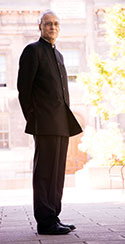by Neale McDevitt
Building tolerance in the post-9/11 world
Five years ago, the world was rocked by the attacks of 9/11. As the Twin Towers came crashing down, it seemed to many people that love, tolerance and spirituality were but artifacts of a bygone era. “After 9/11, many people associated religion—any religion—with evil,” says Arvind Sharma, the Birks Professor of Comparative Religion at McGill. “But religion can be harnessed for good or evil. Fire can cook your food but it can also burn down your house.”
In September 2006, Sharma presided over a global ecumenical congress titled World’s Religions After September 11, held in Montreal. The event brought together religious leaders—from Christian to Wiccan—to confront issues of faith facing the world. “We want to show people that people from different religions can work together,” says Sharma.

At the core of the agenda was the ongoing refinement of the Universal Declaration of Human Rights by the World’s Religions, a process of discussion Sharma deems “as important as the document itself.” The Declaration holds special significance for Sharma. “It covers both the human rights and inter-faith dimensions of my work,” says Sharma, who became a champion of religious diversity and human rights a decade ago after participating in a conference at the request of Harvey Cox, his former Harvard religion professor and one of North America’s pre-eminent theologians.
Since then, Sharma’s research has looked at how even orthodox practitioners can learn from other traditions. In his most recent book, Are Human Rights Western? (Oxford University Press, 2006), Sharma argues that the Western origin of the concept of human rights, even if it emphasizes rights over duties, shouldn’t prevent its application in the East.
He also contends that certain Eastern practices hold useful lessons on religious tolerance. “The Western concept of religious freedom has always assumed you can only belong to one religion. You can’t be both a Jew and a Christian at the same time,” says Sharma. As an example of Eastern openness, he cites a 1985 census of Japan in which more than 95 per cent of Japanese citizens declared they were followers of Shinto and 76 per cent claimed to be Buddhists.
As religions increasingly collide in today’s global village, Sharma’s research provides an antidote to the violence that has become all too commonplace. “India’s classical past is the world’s future,” he says. “Hindus have always felt like they are also in some sense Buddhists, Jains and Sikhs because they have certain elements in their religious composition that derive from these traditions or are held in common with them. Of course, it is not perfect, but in its idealized form, India’s classical past provides the world with a model to deal with religious pluralism.”
Events like the Montreal congress, at which religious leaders worked together to resolve conflict and disharmony, serve as an example for those people who commit crimes in the name of religion. “Fanaticism results from being blinded by the intensity of the luminosity of one’s own tradition—by standing too close to it, instead of seeing the whole world transfigured by it,” he says. “Once you start seeing the riches of other religions and begin meeting people of other faiths who are very similar to you, you don’t stand so close. There is no better solvent for prejudice than actual human contact.”
World’s Religions After September 11 was funded in part by Investissement Québec.
